Coventry, England, a city of 250,00 in the West Midlands, boasted significant industrial power when the Europe went to war in 1940, industries Hitler wouldn’t and didn’t miss. When the Battle of Britain began, a specific Coventry blitz started immediately and didn’t end for three long months–198 tons of bombs killed 176 people and injured almost 700.
But the worst was yet to come. On November 14, 1940, 515 Nazi bombers unloaded, and left the city in ruins. Its own air defenses fired 67 hundred rounds, and brought down only one bomber. It was a rout.
At 8:00 that night, St. Michael’s, a fourteenth-century cathedral, was destroyed like so much else as a city turned to ruin.
In the skeletal hulk of that cathedral, the BBC recorded an ancient hymn that originated in Coventry in the 16th century, part of a series of morality plays. The BBC’s Christmas program that night was broadcast from the heart of Britain’s “darkest hour,” and perhaps because it was, from that day forward, people remembered that ancient hymn in great part because they couldn’t forget it.
Today, that hymn is called “The Coventry Carol,” and it’s unlikely any of you would find it unfamiliar. The story of that ancient hymn is told in a Christmas tale whose shuddering horror is easier not to remember. After the birth of Jesus, King Herod, determined to hold on to his own kingdom, ordered the execution of every living male child under two years old. To imagine the anguish that flowed down streets all through the region is impossible.
In the old Coventry morality plays, “The Coventry Carol” was sung by three Bethlehem women holding babies sentenced to die. Together, those mothers create a haunting melody of multiple vocal lines. If you’ve not brought the “Coventry Carol” together with its own incredible history, you’ll never listen again without hearing the horror of its setting.

The event traditionally called “The Massacre of the Innocents,” is probably best not spoken of on Christmas Eve. It’s way too dark. That most of us sing “The Coventry Carol” right along with “Little Town of Bethlehem” and “Santa Claus is Coming to Town” may well be a blessing.
The “massacre of the innocents” shares the calendar with another historical massacre, this one a day’s travel west of here, a massacre on the open plains beside a creek with an strange name, Wounded Knee. That was exactly 127 years ago today, December 29, 1890.
For a year or more, Native people were gathering all over the West for a religious dance white men determined to be hostile, something called the Ghost Dance. Fear of and hate for Indians brought together the largest gathering of cavalry troops anywhere since the Civil War.
In late-December cold. Big Foot, a Mineconjou chief from the Cheyenne River Reservation, known as a peacemaker, was leading his band south to the Red Cloud Agency, when they were stopped by troops from the Seventh Cavalry, who, a couple decades before, had taken a beating with Custer at the Little Big Horn. On a cold morning–this morning, December 29–in a bloody action that ran on for two agonizing hours, 300 men, women, and children, the Lakota say, were massacred in the last fight of what historians call “The Great Sioux Wars.”
To my ears at least, the haunting harmonies of “The Coventry Carol” could just as easily rise from the frozen prairies all around Wounded Knee, as do the lyrics of that ancient medieval lament. Musically at least, the carol’s spectral choral line—“lully, lulay, lully, lulay”–has nothing in common with the chorus of Lakota death songs sung that day on the plains.
But don’t be fooled. Despair speaks a universal language. The words of those Bethlehem women, “lully, lulay,” are, I’m told, an old English expression that long ago fell out of usage. Linguists say that chorus—“lully, lulay, lully, lulay”—repeats the agonizing testimony of those distraught Bethlehem moms: “I saw, I saw; I saw, I saw.” Who among the survivors would not have chanted something similar?
The Massacre of the Innocents may be folklore; some would argue so.
But Wounded Knee most certainly is not, and the determined lament of the old language holds true just the same, on the killing fields out west of here. “Lulay, lully.” I saw. I saw.
Although none of us may have been there, all of us were.


